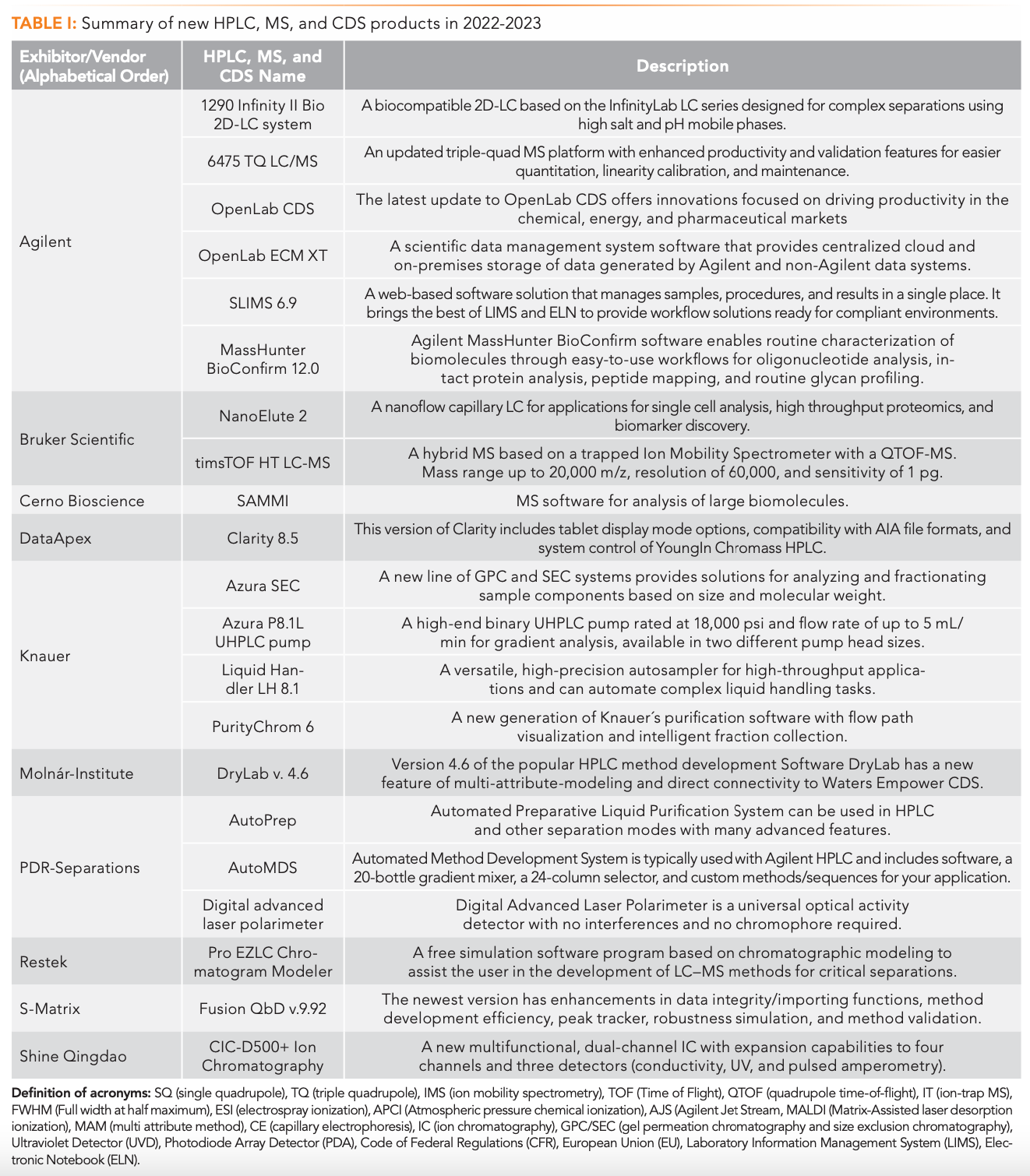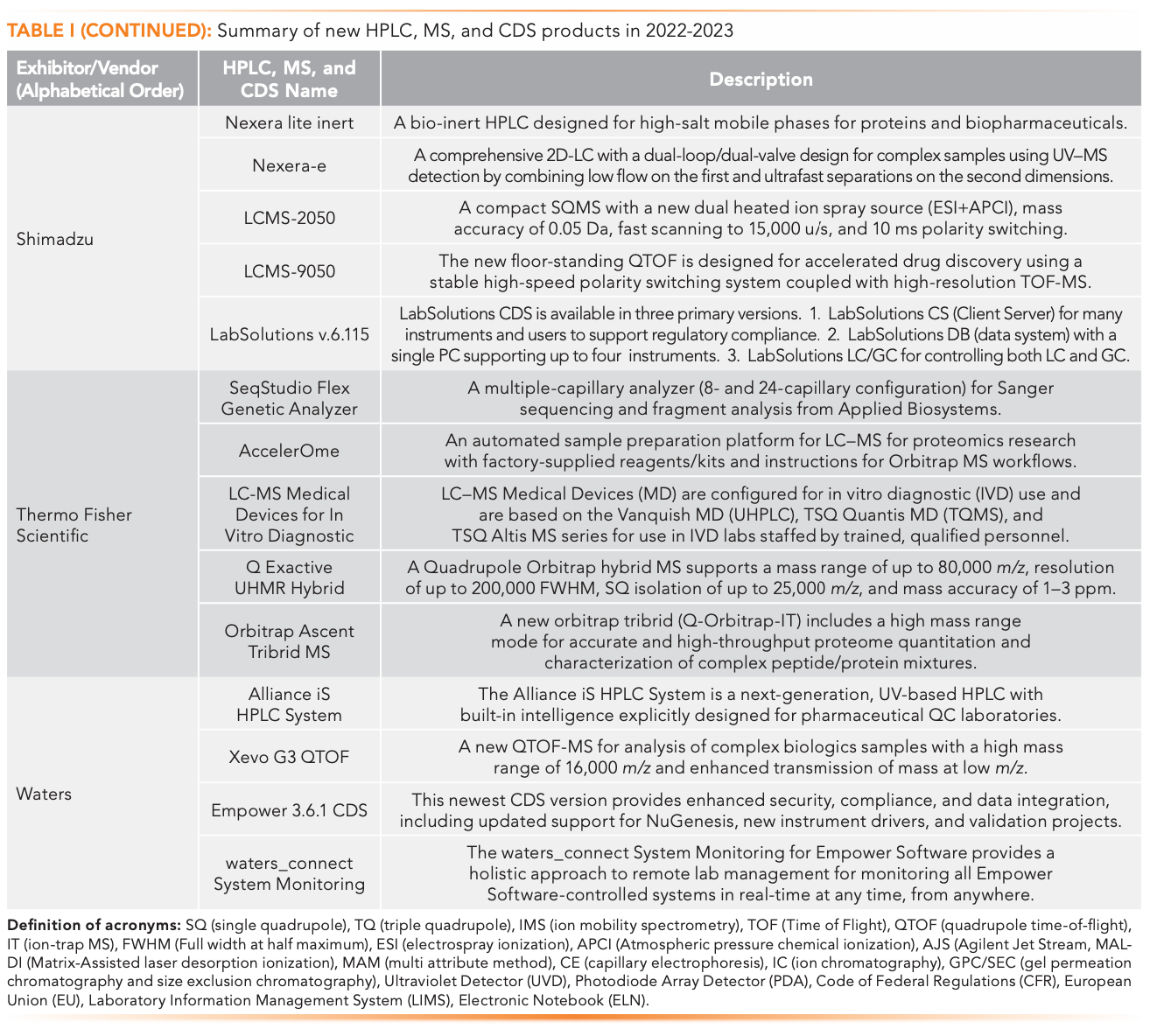Reflections from Pittcon 2023: A Look at HPLC and MS New Product Introductions from 2022–2023
Throughout 2022–2023, instrument manufacturers released new HPLC and mass spectrometry (MS) products into the market. Pittcon 2023 gave these companies an opportunity to showcase them in-person in front of thousands of conference attendees. Although not all manufacturers attended Pittcon this year (in fact, several big manufacturers opted out of attending), that does not mean their products are any less worthy of discussion.
Table I lists new product introductions ordered alphabetically by the vendor’s name from 2022 to 2023, categorized as HPLC systems, modules, MS, CDS, and other software. The HPLC system category includes ion chromatography (IC), LC–MS, and capillary electrophoresis (CE) instruments. Each product’s features and benefits are briefly described, including a summary of specifications (including, but not limited to, pressure and flow rate ranges, mass range, resolution, and scan rates). The footnotes of Table I define the common acronyms used in the text.


HPLC/UHPLC Systems (Including IC, CE, LC–MS, and Preparative LC)
This section describes new HPLC, UHPLC, IC, CE, and LC–MS systems and their salient features, benefits, and technical specifications.
Agilent 1290 Infinity II Bio 2D-LC System
The 1290 Infinity II Bio 2D-LC is a biocompatible system with easy-to-use software for complex separations based on the InfinityLab LC series. It supports a wide range of LC modules withstanding high salt and pH conditions for biomolecule analysis. It can operate in either comprehensive or heart-cutting modes under two software platforms (OpenLab CDS for UV and SQMS with mass selective detector [MSD] or MassHunter for QTOF and TQMS).
Bruker Scientific NanoElute 2
The NanoElute 2 is a nanoflow capillary LC for applications from a single cell to high throughput proteomics, biomarker discovery, intact protein characterization, glyco- and phosphor-proteomics. The system uses two syringe pumps (1550 μL) at a 20–2000 nL/min flow rate.
Knauer Azura Size-Exclusion Chromatography (SEC)
Knauer Azura SEC is a line of gel permeation chromatography (GPC)/SEC systems for polymer and biopolymer analysis. Four configurations are available: SEC Compact, SEC Lab with multiple detector options, SEC semiprep (up to 50 mL/min), and GPC cleanup. The system is compatible with ClarityChrom or PurityChrom CDS.
PDR-Separations AutoPREP
Automated Preparative Liquid Purification System can be used in HPLC, supercritical fluid chromatography (SFC), countercurrent chromatography (CCC), centrifugal partition chromatography (CPC), and simulated moving bed (SMB) applications with many advanced features. It includes an injector/ collector module or universal remote valve control module, and allows for changes without stopping the method, thus recalculating a test run to optimize collection settings.
PDR-Separations AutoMDS
The Automated Method Development System is typically used with the Agilent HPLC. It includes software, a 20-bottle gradient mixer, a 24-column selector, and custom methods and sequences for your application. A data processing tool quickly screens results to show only those chromatograms exhibiting appropriate separations.
Shine Qingdao Shenghan Chromatograph Technology CIC-D500+ IC
The CIC-D500+ Ion Chromatograph is a new multifunctional, dual-channel IC with expansion capabilities to four channels and three detectors (conductivity, UV, and pulsed amperometry). Applications supported include analysis of anions, cations, chemicals, and sugars.
Shimadzu Nexera Lite Inert
Nexera lite inert is a bio-inert HPLC designed for high-salt mobile phases, which are needed for many proteins and biopharmaceutical applications by preventing corrosion and sample adsorption. The maximum pressure is 30 MPa, and flow path materials are based on polyether ether ketone (PEEK), ruby, sapphire, perfluoro elastomer, and polyethylene with a pH compatibility range of 1–14.
Shimadzu Nexera-e
The Nexera-e is a comprehensive 2D-LC instrument with a dual-loop/dual-valve design for complex separations using UV/MS detection by combining low flow on the first dimension and ultrafast separations on the second dimension. The system uses LabSolutions CDS for system control and data handling and the ChromSquare software to analyze photodiodearray (PDA) data.
Thermo Scientific AccelerOme
The AccelerOme is an automated sample preparation platform for LC–MS in proteomics research. It uses factory-supplied reagents and kits, and comes with instructions for Orbitrap MS workflows.
Thermo Scientific LC–MS Medical Devices for In Vitro Diagnostics
Designed for versatility and accuracy, LC–MS medical devices (MD) are configured for in vitro diagnostic (IVD) use. The portfolio consists of an HPLC (Thermo Scientific Vanquish MD HPLC system) and two MS (Thermo Scientific TSQ Altis MD series and Thermo Scientific TSQ Quantis MD series) instruments, differentiated by sensitivity. The systems are for in vitro diagnostic use only.
Thermo Scientific SeqStudio Flex Genetic Analyzer
The SeqStudio Flex Genetic Analyzer from Applied Biosystems is a medium throughput instrument (8- and 24-capillary configuration) for Sanger sequencing and fragment analysis. Designed for genomics research with a single base resolution, the system’s flexibility includes continuous plate loading and four-plate capacity, and it has improved connectivity and serviceability options.
Waters Alliance iS HPLC System
The Waters Alliance iS (intuitive simplicity) is a next-generation UV-based integrated HPLC System with built-in intelligence designed specifically for pharmaceutical QC laboratories. The system consists of the Alliance iS HPLC system, Empower CDS version 3 Feature Release 4, and eConnect HPLC columns. The system intelligence helps prevent operational errors by up to 40% using an intuitive touchscreen, offering guided workflows, system status, troubleshooting, and maintenance procedures. The new Alliance iS HPLC System has intuitive real-time monitoring of system operational status and uses eConnect-enabled HPLC columns. The injector has a flow-through needle design (split-loop) with reduced carryover. The maximum operating pressure is upgraded to 9500 psi with a usable pH range of 1–13. The new Alliance iS HPLC System is equipped with a tunable UV detector and features tool-free, finger-tightened fittings tested to 300 re-uses.
HPLC Module
PDR-Separations Digital Advanced Laser Polarimeter
The Digital Advanced Laser Polarimeter is a universal optical activity detector with no interferences and no chromophore required. New all-digital processing rejects non-flow-related noise, is highly accurate, and has automatic calibration. Sensitivity is a few micro degrees with applications in HPLC, UHPLC, SFC, CCC, CPC, and SMB.
Knauer Azura P8.1L UHPLC Pump
The new Azura P 8.1L UHPLC pump offers a maximum delivery pressure of 18,000 psi (1240 bar), and a flow rate range of up to 5 mL/min for ultra-fast and high-resolution applications. The pump has adaptive pulsation compensation independent of flow rate, backpressure, and eluent type through real-time eluent compress- ibility monitoring, variable piston stroke, and proprietary advanced piston drive technology. It is recommended for demanding applications, such as with TFA containing mobile phases, or with a gradient starting at a low percentage of organic solvents.
Knauer Liquid Handler LH 8.1
A versatile LC autosampler for high-throughput applications and can automate complex liquid handling tasks with high precision and flexibility.
Mass Spectrometers (MS)
Agilent 6475 TQ-MS
The 6475 TQ-MS has productivity and validation features for easier quantitation, linearity calibration, and maintenance procedures. It supports ESI, AJS, and APCI sources with a mass range of 5–3000 m/z, a resolution of 0.4–2.5 Da (FWHM), and a scan speed of up to 18,700 Da/s. It uses MassHunter CDS for control and data handling.
Bruker Scientific timsTOF HT LC–MS
The timsTOF HT LC–MS is a hybrid MS based on a trapped Ion Mobility Spectrometer and a Q-TOF MS. It has a mass range of up to 20,000 m/z, a mass resolution of up to 60,000, and a sensitivity of 1 pg.
Shimadzu LC–MS-2050
The LC–MS-2050 is a compact SQMS with a new dual-heated ion spray source (ESI+APCI). It has a mass accuracy of 0.05 Da, fast scanning up to 15,000 u/s, and fast polarity switching of 10 ms. The LC–MS instrument is compatible with LabSolution CDS with enhanced data integration to UV data in pharmaceutical and quality control applications.
Shimadzu LC–MS-9050
The LC–MS-9050 is a new floor-standing Q-TOF designed for accelerated drug discovery using a stable high-speed polarity switching system coupled with a high-resolution TOF-MS (with low-ppm mass accuracy). The MS is compatible with Shimadzu’s HPLC frontends or direct probe analysis.
Thermo Scientific Orbitrap Ascent Tribrid MS
Scale up your science with new capabilities for multiplexed quantitative proteomics and native protein characterization on the Orbitrap Ascend Tribrid mass spectrometer, which delivers ultimate experimental throughput, versatility, and ease of use.
Thermo Scientific Q Exactive UHMR Hybrid
The Q Exactive UHMR Hybrid MS operates under Thermo Scientific’s Direct Mass Technology mode with a mass range of up to 80,000 m/z, a resolution of up to 200,000 fwhm, a quadrupole isolation range of 25,000 m/z, and a mass accuracy of 1–3 ppm. Add on Thermo Scientific Direct Mass Technology mode to enable simultaneous charge detection.
Waters G3 QTOF
The Xevo G3 QTOF is designed to analyze complex biologics with a high mass range of 16,000 m/z and enhanced transmission of mass at a low m/z. Applications supported include peptide MAM, intact mass analysis, and confirming sequence information. The MS connects with UNIFI or MassLynx software which supports workflows for biopharma characterization applications.
The Xevo G3 QTOF mass spectrometer is designed for biological, forensic, metabolite identification, and extractables and leachables analysis. The instrument features a high mass range of 16,000 m/z and enhanced transmission of low-mass, labile species. Applications supported include peptide MAM, intact mass analysis, and confirming sequences. The Xevo G3 connects with compliant-ready workflows on the Waters_connect software platform or Waters MassLynx software, which supports workflows for biopharma characterization applications.
Chromatography Data System (CDS) and Other Software
The CDS marketing landscape and other technical information have been described elsewhere (6).
Agilent OpenLab CDS
The latest update to OpenLab CDS offers innovations focused on driving productivity to a higher level, particularly in the chemical, energy, and pharmaceutical markets. The new version allows customers to adopt OpenLab CDS for specific analytical methodologies commonly found in these markets and features continued improvements in data integrity, usability, and analytical support for mass spectrometry workflows. Cloud-based help and learning improves access to learning resources like “Getting Started” modules, “How To” guides, manuals, and more, making accessing the most up-to-date materials easier.
Agilent OpenLab ECM XT
A scientific data management system software that provides centralized cloud and on-premises storage of data generated by Agilent and non-Agilent data systems.
Agilent SLIMS 6.9
A web-based software solution installed either on-premises or cloud-hosted. SLIMS manages samples, procedures, and results in a single place. It brings the best of LIMS and ELN to provide workflow solutions ready for compliant environments. Recent releases include better support of MS and quality control data.
Agilent MassHunter BioConfirm 12.0
BioConfirm software enables routine characterization of biomolecules for oligonucleotide analysis, intact protein analysis, peptide mapping, and routine glycan profiling. BioConfirm is part of the Agilent biopharma workflow, including automated sample preparation, LC separation using the 1290 Infinity II LC, mass spectrometry detection with the 6545XT AdvanceBio LC/QTOF, and full analysis and reporting using BioConfirm biopharmaceutical software.
Cerno Bioscience SAMMI
SAMMI is an MS software for analyzing large biomolecules (peptides, oligos, proteins, and other large molecules). It calculates molecular weights using first principles and accounts for modifications, adducts, impurities, and isotope labels.
DataApex Clarity 8.5
This version of Clarity includes tablet display mode options, compatibility with AIA file formats, and system control of YoungIn Chromass HPLC from Korea.
Knauer PurityChrom 6
PurityChrom 6 is the new generation of Knauer ́s purification software, including a modern interface, new features like an animated flow path, method writing via clicks into system visualization, the configuration of multiple systems, and extended functions for user administration (grouping of users, Windows SID login, SQL server synchronization). PurityChrom 6 meets the standards of GAMP 5 and 21 CFR part 11.
Molnár-Institute DryLab V. 4.6 for HPLC Method Development
Version 4.6 of the popular HPLC method development Software DryLab has a new feature of multi-attribute modeling, which allows the fulfillment of multiple analytical target profiles. Version 4.6 includes an option for a virtual combination of samples (for forced degradation or detection methods) and a direct connectivity to Waters Empower CDS, which enables DryLab to create Sample Set Methods and acquire results back into DryLab.
S-Matrix Fusion QbD Method Development Software v.9.92
The newest version has enhancements in data integrity/importing functions, method development efficiency, peak tracker, robustness simulation, and method validation. It also offers forced degradation study automation support for robustness evaluation and method optimization.
Restek Pro EZLC Chromatogram Modeler
The Pro EZLC Chromatogram Modeler is a free simulation software program offered by Restek based on chromatographic modeling to assist users in developing LC–MS methods for critical separations.
Shimadzu LabSolutions v.6.115
LabSolutions CDS is available in three primary versions. 1. LabSolutions CS (Client Server) for many instruments and users to support regulatory compliance; 2. LabSolutions DB (data system) with a single PC supporting up to four instruments; and 3. LabSolutions LC/GC, a CDS for controlling both LC and GC from the same software. LabSolutions also serves as the basis for individual instrument platforms.
Waters Empower 3.6.1 CDS
This newest Empower CDS version provides enhanced security, compliance, and data integration, including updated support for NuGenesis, new instrument drivers, and validation projects.
Waters_connect System Monitoring for Empower Software
The Waters_connect System Monitoring software is a cloud-native application that monitors the status of any Empower Software-controlled chromatography systems in real time at any time, from anywhere. The software’s dashboard records and displays information about each system, including its history, its real-time operating status, and usage levels.
Summary and Commentaries
This installment provides an overview of new separation science products introduced in 2022–2023. It summarizes innovative features, key benefits, and pertinent specifications of these new HPLC, MS, CDS, and other software products.
I have attended Pittcons for four decades, and Pittcon 2023 remained a rewarding and inspiring experience (7). I want to appeal to all instrument manufacturers to reconsider a return to the most prominent American laboratory conference for the benefit of laboratory scientists and consumers. I am hopeful that the Pittcon organizing committee, which did a stellar job in the past 70+ years, will continue to deliver a global conference of increased relevance to the analytical science community and instrument manufacturers alike.
Acknowledgments
The author thanks the marketing staff of all manufacturers who provided timely responses to the LCGC questionnaires. A special thanks to my reviewers for providing timely technical and editorial inputs to this article: Alice Krumenaker of Hovione, Andrea Otto of Agilent, Kevin MacLaughlin of Shimadzu, Brian Murphy of Waters, He Meng of Sanofi, Giorgia Greco of Knauer, Leon Doneski of Arcutis Biotherapeutics, and Gary Yanik of PDR-Separations.
References
(1) Guillarme D.; Dong M. W. (Eds). UHPLC: Where We Are Ten Years After Its Commercial Introduction. Trends in Anal. Chem. 2014, 63, 1–188.
(2) Dong, M.W. HPLC and UHPLC for Practicing Scientists, 2nd ed.; Wiley, 2019, pp. xxiii-xxiv, 81–116.
(3) Dong, M. W. New HPLC Systems and Related Products: A Brief Review. LCGC North Am. 2022, 39 (4), 172–178. DOI: 10.56530/lcgc.na.jw6767l7
(4) McCullagh J.; Oldham, N. Mass Spectrometry; Oxford University Press, 2019.
(5) Shi, J.; Chen, X.; Diao, J. et al. Bioanalysis in the Age of New Drug Modalities. AAPS J. 2021, 23 (3), 64. DOI: 10.1208/s12248-021-00594-w.
(6) Mazzarese, R.; Bird, S. M.; Zipfell, P.; Dong, M.W. Chromatography Data Systems: Perspective, Principles and Trends. LCGC North Amer. 2019, 37 (12), 852–865.
(7) Dong, M. W. “My Forty Years at Pittcon.” LinkedIn article, March 2, 2023, https://www.linkedin.com/pulse/my-40-years-pittcon-michael-dong-%25E5%2594%2590%25E7%25BA %25AC%25E4%25B8%25AD/?trackingI d=is6JmjqehmlCfyZGI4wUxg%3D%3D
ABOUT THE AUTHOR
Michael W. Dong is a principal of MWD Consulting, which provides training and consulting services in HPLC and UHPLC, method improvement, pharmaceutical analysis, and drug quality. He was formerly a Senior Scientist at Genentech, a Research Fellow at Purdue Pharma, and a Senior Staff Scientist at Applied Biosystems/PerkinElmer. He holds a PhD in Analytical Chemistry from City University of New York. He has more than 130 publications and a best-selling book in chromatography. He is an editorial advisory board member of LCGC North America and the Chinese American Chromatography Association. Direct correspondence to: LCGCedit@mmhgroup.com.

Polysorbate Quantification and Degradation Analysis via LC and Charged Aerosol Detection
April 9th 2025Scientists from ThermoFisher Scientific published a review article in the Journal of Chromatography A that provided an overview of HPLC analysis using charged aerosol detection can help with polysorbate quantification.
Removing Double-Stranded RNA Impurities Using Chromatography
April 8th 2025Researchers from Agency for Science, Technology and Research in Singapore recently published a review article exploring how chromatography can be used to remove double-stranded RNA impurities during mRNA therapeutics production.






